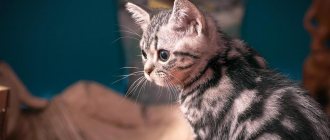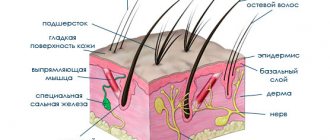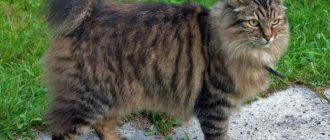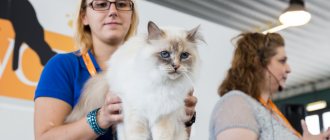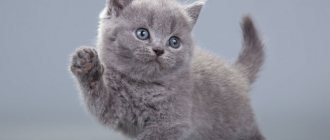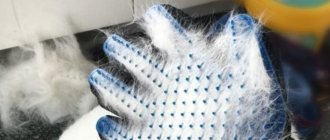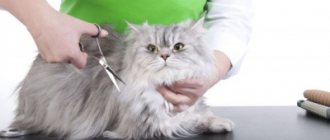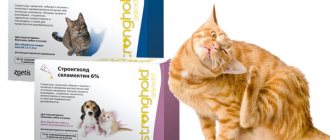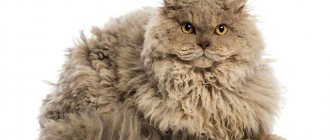Features of fluffy cat breeds
Long-haired cats have a special coat structure: the hairs are quite dense and the undercoat is thick. During seasonal molting, animals are forced to lick dead hairs every day. This routine procedure helps to renew the coat, but most of the hairs remain in the stomach, which causes a lot of trouble. Owners should provide pets with sprouted oat or wheat sprouts to remove hairballs.
Long-haired fluffies have a tendency to develop tangles. Regular licking and combing of the hairs will help solve the problem.
Free range can also ruin the appearance of furry beauties. Dust, debris, thorns, dry leaves are what cats often return from a walk with.
Certain breeds of cats shed all year round, which adds to the worries of their owners. In other breeds, the coat grows back darker after clipping, which leads to disqualification at the show.
The high likelihood of allergic reactions in family members is another feature of fluffy cat breeds. During the molting season, hairs cover literally everything around, clumps of fluff get stuck in corners and under furniture, which complicates cleaning the room. Such animals will have to comb their fur every day. By the way, a robot vacuum cleaner will take on some of the routine work and make life much easier for cat owners.
Advantages and disadvantages
Dense and thick wool has its advantages, but it is not without its disadvantages.
A warm coat protects the animal from the cold, but in summer it can become a real problem. If the owner neglects hygiene rules, the animal runs the risk of developing skin diseases. To maintain an attractive exterior, you will need hard brushes, slicker brushes, combs, and furminators.
In some cat breeds, the fur is prone to fading, so owners should ensure that their pets do not walk under the scorching sun. Under the influence of ultraviolet light, the hairs become dry and brittle.
Long-haired cats often resist when the owner tries to comb their coat, which makes grooming more difficult. Few of the cat family like water treatments, which cannot be avoided if the pet is free-range. Ticks and fleas hide in a thick fur coat and are often invisible. To remove fleas, medications are used that have a negative effect on the coat: the hairs lose their elasticity, become dull and brittle.
Recommendations for choosing a fluffy kitten
How to tell if the kitten in front of you is fluffy? Fluffy cat breeds are noticeable due to several characteristics:
- From a young age they look cute, like a voluminous ball of fur. By the way, they have it wavy and raised.
- The ears and tail are also covered in fur. The more, the softer the adult will be.
- If possible, take a look at his parents. Their breed must be from an internationally verified list or they both appear to be fluffy in appearance.
How to determine if a kitten is fluffy?
Even with all the disadvantages of care, such breeds will always be in demand. Soft and fluffy four-legged animals create an atmosphere of goodness in the house!
Furry breed categories
Cat breeds receive official recognition after passing certification in one of the felinological communities. Animals receive metrics, pedigree and documentary evidence of origin. The exterior must comply with the breed standard. Only a complete package of documents gives the right to selection and participation in exhibitions.
There are more than 700 special species of cats in the world, but international organizations recognize only a few dozen:
- FIFe (World Cat Federation) recognizes 42 breeds.
- European WCF - 70 breeds;
- American CFA Association - 40 breeds.
Breeding work is ongoing, so some resistant phenotypes will periodically receive official recognition.
According to FIFe
According to FIFe, furry varieties include categories I and II, which include the following breeds:
- American Longhaired Curl.
- Balinese cat.
- Burma.
- British.
- Himalayan cat.
- Maine Coon.
- Neva Masquerade.
- Norwegian forest.
- Persians.
- Ragdoll.
- Siberian cat.
- Turkish Angora.
- Turkish van.
- Exotic.
Ragdoll
According to WCF version
According to WCF, furry cat varieties include breeds of categories 1 and 2:
- Long-haired Burmilla.
- Karelian Bobtail
- Kurilian Bobtail.
- Laperm.
- Munchkin.
- Nibelung.
- Oriental.
- Ragamuffin.
- Selkirk rex.
- Somali cat.
- Tiffany.
- Ural rex.
- Highland fold.
- Japanese Bobtail.
Ragamuffin
According to CFA
The CFA recognizes the same cat species as the WCF and FIFe with the exception of: American Bobtail, Ojos Azules, Pixie Bob.
I and II categories according to FIFe
FIFe has defined breeds in it that are also recognized by other major communities. Thus, with the official documents of the club, they can be called fluffy:
- American Longhair Curl,
- British,
- Himalayan,
- Maine Coon,
- Persian,
- sacred Burmese,
- Siberian individuals,
- Neva Masquerade,
- turkish angora,
- exotic (exotic),
- ragdoll,
- norwegian forest,
- Turkish van.
More details about outstanding cuties, with photos and descriptions:
British
Fluffy kittens: British breed
Strong, regal, with expressive eyes and silky fur. The Britons are believed to be descended from the Chartreuse species. But over time, they grew thicker fur in response to England's harsh climate. In the 17th century, these cats found shelter in every home, because, in addition to their chic appearance, they have developed hunting talent!
Their coat is dense, with developed undercoat, and plush to the touch. The color can be different: solid (gray-blue, black, chocolate), smoky, tortoiseshell, tabby, two-color, colorful (the tail, paws, ears and muzzle are pigmented).
You definitely want to cuddle such a plush pet. But by nature the cat is reserved and unobtrusive. He will tolerate your expressions of love and even if he loves you himself, he will not show it so openly.
Persians
Fluffy breeds: Persian kitten
The British Longhair was bred from the British Shorthair and the Persian breed. After all, Persians are record holders for the length of fur and have long been considered an ideal, royal breed. They are the oldest breed of cats.
Felinologists have not come to a consensus on the origin, but there is a general assumption about the reason for the length of the hair. Such wool appeared as a result of a natural mutation: the undercoat changed with the outer hairs. And then the breeders achieved the desired length, density and color. Now it is thick fur with thin but soft hairs, which can reach up to 15 centimeters. He has such fluffiness throughout his entire body, from the “collar” to the bushy tail.
Burmese
Fluffy breeds: Burmese kitten
The Sacred Burmese is also bred by crossing with a Persian, this time with a Siamese cat. The animal is distinguished by its beautiful colors, docile nature and simple care requirements.
Fur of medium length with short undercoat. In this case, the longest hair is located on the sides and back. On the pet’s head it lengthens towards the cheeks, and below it turns into a thick “collar”. The tail is medium, but seems even shorter due to the voluminous hair on it.
Burmese are loving, so they are perfect for a family home. They extend their friendly nature to children, adults, and even other animals.
Other breeds
- The Maine Coon is one of the largest cat breeds (height 0.4 m, length 1.2 m). But behind the menacing appearance lies a soft, tame cat with a fluffy coat. Furry seeps between the clawed fingers, on the huge tail, even on the tufts of the ears. If the Maine Coon's hair does not lengthen on the belly and hind legs, this is considered a fault in the animal's breed.
Fluffy Maine Coon kitten
- Balinese (Balinese) cat. A breed offshoot of the Siamese is the color point color. The fur is semi-long, hard. They are perfect for families with children due to their good nature and sociable behavior.
Balinese cat breed (fluffy breeds)
- Himalayan. Like many of the fluffies on the list, they are descendants of Siamese, and from them they received the characteristic color-point color. The other parent is Persians. Therefore, the fur standard for them is considered to be voluminous hair all over the body, which becomes longer on the neck, forming a mane.
Fluffy Himalayan cat kitten
- Siberian. Characteristic forest color and ancient history. Cats of this species are powerful, beautiful, with a developed hunting instinct. The coat consists of a semi-long main hair - hard, shiny, with water-repellent properties - and a double undercoat (short in warm periods, voluminous and long in cold periods). It all looks like a lush “collar” on the neck and “pants” on the hind legs.
Purebred fluffy Siberian kittens
- Norwegian forest (skogkatt). Ancestors are wild cats of Scandinavian forests. Therefore, their color acts as a camouflage, protecting them from attentive eyes. Skogkatt has developed muscles and by the age of 4-5 years reaches a weight of 20 kg. At the same time, the animal remains a graceful conqueror of forests. The fur is double with a thick down, forms a “collar” on the neck, and “socks” on the hind legs, which allowed this breed to be included in the FIFe list. In addition, wool is water-repellent.
Norwegian Forest Cat (fluffy breeds)
- Neva Masquerade. Bred from Siberian cats, but has bright blue eyes and a carnival mask-like face color. They are long-haired, with a dense double undercoat. At the same time, the hairs are smooth and shiny, shorter on the shoulder blades, and beautifully descending on the sides, forming a mane, frill and “pants”. Shedding occurs twice a year, but if you brush it out with a brush with metal teeth, it will go away almost unnoticed.
Fluffy cat breeds: Neva Masquerade
- Exotic. An independent breed with Persian roots, but, unlike them, the hair is shorter, which makes grooming easier. Its popularity among pet lovers around the world is due to the pet’s docile nature and unusual appearance: short legs, thick build, characteristic muzzle and snub nose.
Fluffy exotic kitten
- Turkish Angora, Turkish Van. A resident of any climate can become the owner of this breed, and this without any consequences for the health of the animal. Lake Van has endowed the breed with the ability to swim in extreme temperatures: light wool perfectly keeps the animal afloat, protects it from high temperatures, and its structure allows it to emerge from the water almost dry. To protect against low temperatures, the animal grows a thick undercoat, so it easily gets used to the cold.
Turkish Angora: list of fluffy breeds
Turkish Van: list of furry breeds
The most beautiful fluffy cat breeds
According to breeders and cat owners, the most beautiful breeds are British, Maine Coon, Angora, Neva Masquerade, Persian, Ragdoll, and Scottish Fold.
The most affectionate
Cats with the most affectionate and flexible character: Ragdoll, Neva Masquerade, British, Persian, Burmese, Maine Coon, Oriental.
With a flattened muzzle
Year after year, cats with flattened faces top the ranking of the most popular breeds: Persian, Scottish Fold, British, Himalayan, and exotic.
Which don't shed
Non-shedding cats are a myth. Such breeds do not exist in nature. Animals shed dead hairs regardless of the length of their fur. However, cats with coarse or curly fur shed the least: rexes and representatives of the Siamese-Oriental group. Bengals, Nibelungs and Tiffanys shed slightly.
Chantilly Tiffany
Breeds recognized only by the CFA
Basically, this organization recognizes the same species of furry felines as the above organizations.
- The American Bobtail is similar to other varieties of short-tailed cats both in appearance and in character, but differs in the shape of its head and the tufts on its rounded ears.
- Ojos azules, with soft cream-colored fur and sky blue eyes.
- The Pixie Bob looks like a fluffy munchkin, so other associations do not distinguish it as a separate breed. A distinctive feature of such cats is not only short legs, but also tufts on their ears.
The nuances of keeping cats of fluffy breeds
A luxurious fur coat requires careful care. Breeders advise accustoming a kitten to hygiene procedures from an early age, so that in the future water treatments and brushing will not cause aggression.
Individuals with a thick undercoat should be brushed twice a week. A furminator will be a cat owner's best friend. The tool deals with fluff in no time, and cats do not perceive such combing as an execution. On the contrary, most pets like it when their fur coat is combed with a furminator.
It is better to brush Persians with a slicker brush due to the special structure of their coat. The tool copes well with the airy fur of Persian cats.
For curly-haired felines, stiff brushes and combs are suitable. It is important to use the tool carefully so as not to damage the hairs.
It is not advisable to neglect the procedure for combing fluffy long-haired cats, because their hairs are prone to tangling, and then the tangles are difficult to comb out; all that remains is a haircut.
Veterinarians advise adding vitamin and mineral complexes to the diet to maintain healthy coat and skin.
Representatives of the Tiffany breed have a unique coat structure that requires minimal grooming. The structure of the hairs is thin and velvety, so they do not tangle and do not catch dust and dirt thanks to the special enveloping coating.
Persians need more careful care, because animals often lick shedding hairs that clog their stomach. Cats need to be given medications to remove the lumps.
Tendency to disease
Representatives of aboriginal breeds (Siberian cat, Maine Coon, Turkish Van, Angora, Neva Masquerade) can boast of enviable health. They rarely suffer from infectious diseases and are not susceptible to genetic pathologies.
Hybrid breeds, created by crossing several breeds, are often prone to hereditary diseases. For example, Scottish fold cats suffer from pathologies of the cardiovascular system, have problems with the kidneys and teeth.
A whole bunch of genetic diseases have been discovered in Persians. The nose and eyes are primarily affected due to the special structure of the skull. Cats have difficulty breathing due to an abnormal structure of the nasal septum. Animals suffer from severe diseases such as:
- renal failure;
- viral rhinotracheitis;
- hypertrophic cardiomyopathy;
- retinal atrophy.
Exotics inherited from the “Persians” a tendency to conjunctivitis.
Orientals suffer from gastrointestinal diseases, bronchial asthma, heart pathologies, retinal atrophy, and strabismus.
Balinese cats are diagnosed with congenital heart defects.
Mr. Cat recommends: popular breeds
The popular recognition of the breed is influenced by completely different factors than the official one. Subspecies that are affordable, widespread, and prolific (you don’t have to wait several years for a kitten) are becoming popular.
An easy-going and friendly character and the absence of difficulties with nutrition and care play an important role.
Thanks to the combination of positive qualities and the availability of purebred kittens with documents, Turkish Angoras, Maine Coons, Persians, Siberians, Norwegian Forest cats and all subspecies of Asian longhaired cats with a characteristic Siamese color become domestic fluffies.
Friendly Norwegian Forest
This breed is similar in appearance to a Siberian cat – it has the same thick hair and large dimensions. The weight of an adult is about 8 kg. In terms of popularity, the Norwegian forest is significantly inferior to the Siberian, which is why it is even more valuable. The advantage of the breed is its ease of care. Despite the thick coat, mats rarely form. The pets themselves are friendly, get along well with children and get along well with other representatives of the animal world.
Turkish Angora
Blue-eyed, fluffy cats of this breed have thick and long hair, the color of which is most often white or gray. The body is muscular and graceful. Externally, the Turkish Angora is unlike any other breed, as it has a small head, an elongated neck and a very fluffy tail, reminiscent of a squirrel.
A furry cat's eyes can be green, brown or amber . Representatives of this breed often experience heterochromia, a genetic disease in which the pupils of the eyes are colored different colors.
© shutterstock
Pets of this breed have developed intelligence and can easily learn all skills. They can also be trained to follow simple commands.
Severe Siberian cat
Perhaps the most popular breed among “fluffies”. It enjoys attention not only in our country, but also far beyond its borders. The peculiarity of the breed is associated with the living of animals in severe Siberian frosts. A chic fur coat allowed animals to keep warm and prevent moisture from entering.
Siberian cats have one important advantage - they are recognized as hypoallergenic. Even despite a decent amount of fur, there are no allergens on it, and they do not shed as actively as representatives of other fluffy breeds. The dimensions of these special ones are also impressive. They can weigh up to 9 kg.
